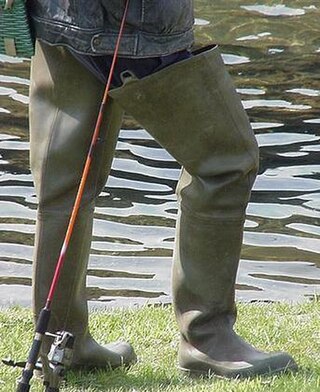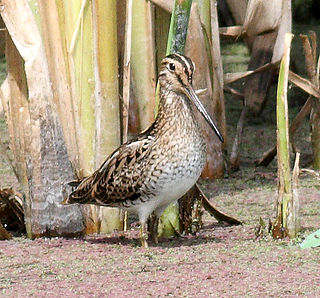
Waders or shorebirds are birds of the order Charadriiformes commonly found wading along shorelines and mudflats in order to forage for food crawling or burrowing in the mud and sand, usually small arthropods such as aquatic insects or crustaceans. The term "wader" is used in Europe, while "shorebird" is used in North America, where "wader" may be used instead to refer to long-legged wading birds such as storks and herons.

The oriental pratincole, also known as the grasshopper-bird or swallow-plover, is a wader in the pratincole family, Glareolidae.

The Royal Australasian Ornithologists Union (RAOU), now part of BirdLife Australia, was Australia's largest non-government, non-profit, bird conservation organisation. It was founded in 1901 to promote the study and conservation of the native bird species of Australia and adjacent regions, making it Australia's oldest national birding association. In 1996, the organisation adopted the trading name of Birds Australia for most public purposes, while retaining its original name for legal purposes and as the publisher of its journal, the Emu. In 2012, the RAOU merged with Bird Observation & Conservation Australia to form BirdLife Australia.

Eighty Mile Beach also spelled Eighty-mile Beach or 80-mile Beach, and formerly called 90-mile Beach, lies along the north-west coast of Western Australia about half-way between the towns of Broome and Port Hedland. Despite its name, it is some 220 kilometres (140 mi) in length, forming the coastline where the Great Sandy Desert approaches the Indian Ocean; this makes it arguably the longest beach in the world, although the coastline paradox makes this practically impossible to determine for sure, with Praia do Cassino in Brazil possibly being longer. It is one of the most important sites for migratory shorebirds, or waders, in Australia, and is recognised as a wetland of international importance under the Ramsar Convention on Wetlands.

The spoon-billed sandpiper is a small wader which breeds on the coasts of the Bering Sea and winters in Southeast Asia. This species is highly threatened, and it is said that since the 1970s the breeding population has decreased significantly. By 2000, the estimated breeding population of the species was 350–500.

Waders denotes a waterproof boot or overalls extending from the foot to the thigh, the chest or even the neck. They are traditionally made from vulcanised rubber, but available in more modern PVC, neoprene and Gore-Tex variants. Waders are generally distinguished from counterpart waterproof boots by shaft height; the hip boot extending to the thigh and the Wellington boot to the knee. For the sake of emphasis, therefore, waders are sometimes defined by the extent of their coverage as thigh waders, chest waders or full-body waders. As a drysuit variant, full-body waders come with leaktight cuffs or gloves fitted to the sleeves and with a leaktight collar or hood fitted to the neck, enabling the wearer to remain dry when standing or walking in deeper water. Waders are available with boots attached or can have attached stocking feet, to wear inside boots, or inside swimfins in the case of float tube fishing.
The Stilt is the journal of the Australasian Wader Studies Group (AWSG), a special interest group of the Royal Australasian Ornithologists Union, also known as Birds Australia. It was first issued in 1981.

The Broome Bird Observatory is an educational, scientific and recreational facility located 24 km from Broome in the Kimberley region of Western Australia. It began operating in 1988 under the auspices of the non-profit organisation Birds Australia to provide a base for the study and enjoyment of the birds of Roebuck Bay and adjoining areas. The bay boasts the highest diversity of migratory waders in Australia. In March and April, immense flocks of waders can be watched as they depart to their breeding grounds in the northern hemisphere.
Clive Dudley Thomas Minton, AM was a British and Australian metallurgist, administrator, management consultant and amateur ornithologist. His interest in birds began in childhood.

The East Asian–Australasian Flyway is one of the world's great flyways of migratory birds. At its northernmost it stretches eastwards from the Taimyr Peninsula in Russia to Alaska. Its southern end encompasses Australia and New Zealand. Between these extremes the flyway covers much of eastern Asia, including China, Japan, Korea, South-East Asia and the western Pacific. The EAAF is home to over 50 million migratory water birds from over 250 different populations, including 32 globally threatened species and 19 near threatened species. It is especially important for the millions of migratory waders or shorebirds that breed in northern Asia and Alaska and spend the non-breeding season in South-East Asia and Australasia.

The Miranda Naturalists' Trust is a charitable trust, that established and maintains the Miranda Shorebird Centre, located at Pūkorokoro / Miranda on the western shore of the Firth of Thames on the North Island of New Zealand. The Miranda Naturalists' Trust (MNT) was formed in 1975 to encourage people to visit the coastline and appreciate its wide range of flora and fauna. The trust promotes education and public awareness of coastal ecology, shorebird research and conservation. Work done by the trust, to increase knowledge of shorebird migration, includes bird banding, research and data exchange. The Shorebird Centre has information displays on waders and a library and helps raise funds for the trust's work through their shop sales and visitor accommodation.
The Bass Pyramid, part of the Furneaux Group, is a small, two sectioned oval, steep-sided 100-square-metre (1,100 sq ft) unpopulated granite island, located in Bass Strait, lying north of the Flinders Island and south of the Kent Group, in Tasmania, Australia. A rock bridge connects the two sections.

The Cat Island, part of the Babel Group within the Furneaux Group, is a 39-hectare (96-acre) unpopulated granite island, located in Bass Strait, lying off the east coast of Flinders Island, Tasmania, south of Victoria, in south-eastern Australia.
Birds Korea is an organisation dedicated to the conservation of birds and their habitats in South Korea and the wider Yellow Sea Eco-region.
The Victorian Wader Study Group (VWSG) is an Australian non-profit, volunteer, ornithological fieldwork group that gathers biometric and other data on waders and terns, mainly through regular catches of large samples of several species by cannon-netting at sites along the coast of Victoria.

The Hunter Estuary Wetlands comprise a group of associated wetlands at and near the mouth of the Hunter River in the city of Newcastle, New South Wales, Australia. The wetlands are part of Hunter Wetlands National Park. 30 km2 of the wetlands have been recognised as being of international importance by designation under the Ramsar Convention. It was listed on 21 February 1984 as Ramsar site 287. A larger area of the wetlands has been identified by BirdLife International as an Important Bird Area (IBA). The wetlands are recognised as the most important area in New South Wales for waders, or shorebirds.

BirdLife Australia is a not-for-profit organisation advocating for native birds and the conservation of their habitats across Australia.

The Swan Bay and Port Phillip Bay Islands Important Bird Area comprises a cluster of disparate sites centred at the eastern end of the Bellarine Peninsula, and the southern end of Port Phillip, in Victoria, south-eastern Australia. As well as providing core wintering habitat for orange-bellied parrots, it is important for waders, or shorebirds, and seabirds.












